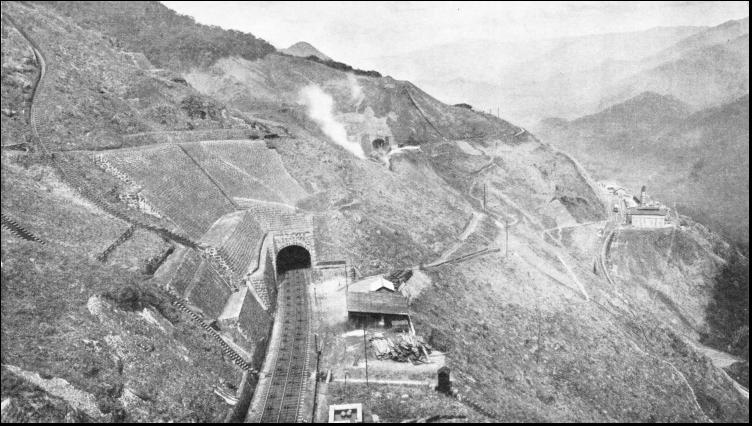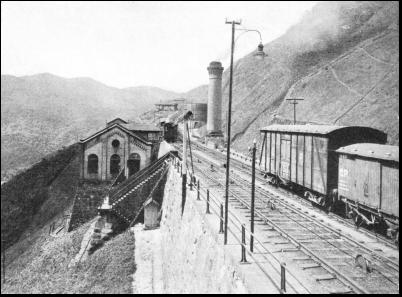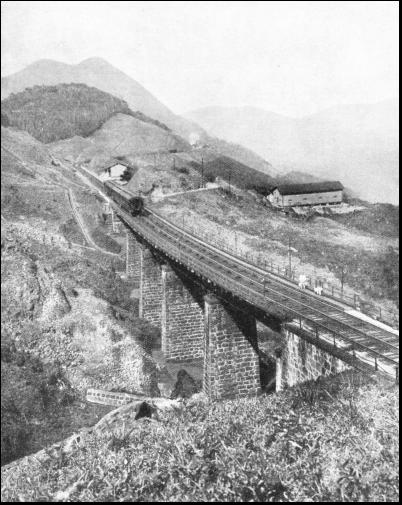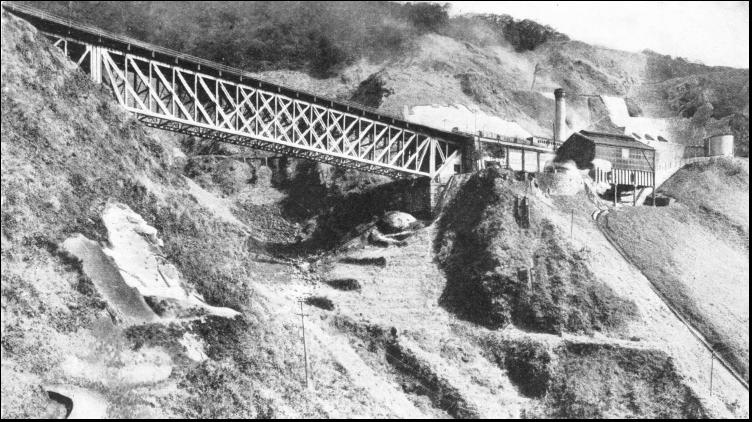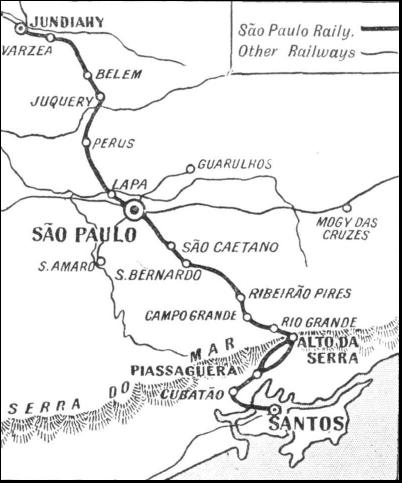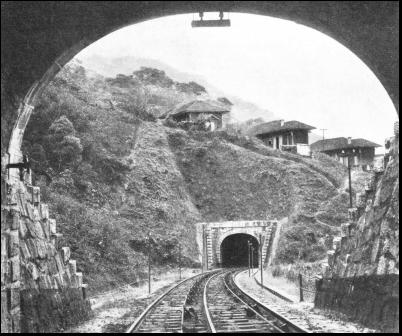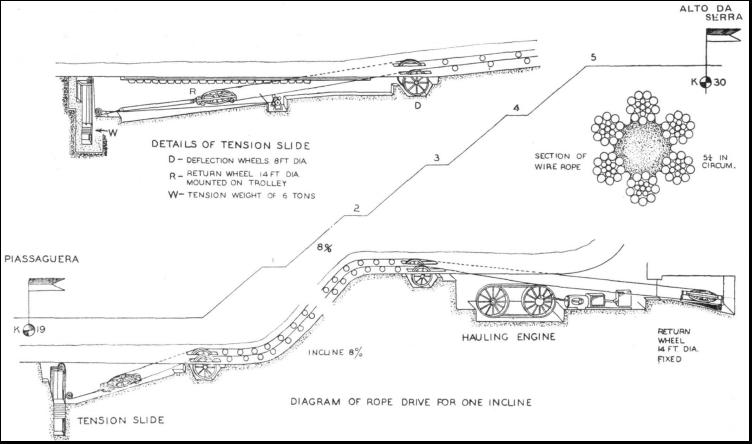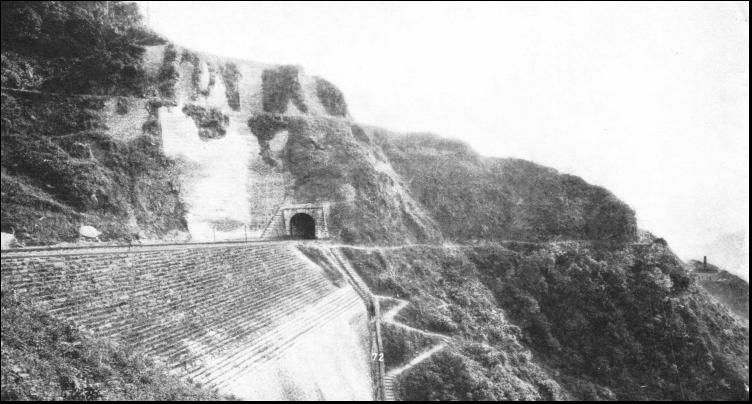|
|
IT is the work of the pioneer that deserves man's sincere admiration, whether the task succeeds or fails against overwhelming odds within sight of achievement. Ranking high among the world's great feats of pioneering are the famous cable inclines of the Serra do Mar—natural ramparts of Brazil. For more than seventy years these marvellous inclines, part of the Sao Paulo Railway, have linked the great plateau of Brazil with the Southern Atlantic Ocean. In course of time other lines have been built, with trains that climb Brazil's barrier range by the use of gear wheels and the familiar rack rail of mountain railways. But the inclines of Serra do Mar are unique in the annals of engineering. The older inclines constitute a railway that rises 2,625 feet in five miles. The newer inclines have a total length of about seven miles. With its area of 3,300,000 square miles, Brazil is more than twenty-seven times the size of the British Isles. The maritime State of Sao Paulo produces four-fifths of the coffee consumed by the whole world. But the City of Sao Paulo, capital of Sao Paulo State and centre of the coffee plantations, is separated from Santos, Brazil's port on the Atlantic, by the cliffs of the Serra do Mar. More than a hundred years ago an awakening Brazil was determined to have an outlet to the sea, and in 1839 the Brazilians submitted a scheme to Mr. Robert Stephenson for building a railway across the Serra. That proposal was, however, a little premature and the conquest of the obstacle was deferred. Nearly twenty years later, when the necessity for a scheme had become more apparent, a leading Brazilian, Baron de Maua, and a number of his fellow countrymen obtained a concession from their Government to build a railway. The proposed line was to run from Santos to Sao Paulo and thence northwest to the important centre of Jundiahy. Baron de Maua lost no time in ordering the necessary surveys from Jundlahy to the top of the Serra do Mar. That part of the work presented trouble enough, but the scaling of the range barring the way to the coast was regarded as a railway impossibility. There was no question of outflanking the range, as there were no passes. The Serra do Mar had to be climbed. Building a railway up a cliff-side to a height of 2,625 feet called for engineering skill such as could be acquired only by world-wide experience.
Baron de Maua therefore sent to Great Britain, birthplace of railways, for advice and assistance. The man whose services were so eagerly sought was James Brunlees, a well-known railway engineer, and his first problem on the proposed Sao Paulo Railway was set by the holders of the concession. This problem was one of cost. The contract offered by Baron de Maua outlined a broad gauge (5 ft. 3 in.) railway, taking the shortest route between Santos and Jundiahy, and stipulated that. the cost for the whole undertaking, including the scaling of the Serra, was not to exceed the figure of £2,000,000. Brunlees saw the Serra, decided that the railway could climb the cliffs at a cost within the imposed limits, and accepted the contract. Then he tackled his next problem, to find a man who, by training and instinct, was capable of carrying the task to a successful finish. Brunlees's choice fell on a man he had himself trained—Daniel Makinson Fox. This young man, who was only twenty-six at the time, had even then made a reputation as a railway engineer. Further, he had gained considerable experience in the building of mountain railways in North Wales and among the ranges of the Pyrenees. His knowledge of Spanish, acquired in the Pyrenees, was later to prove of assistance to him in understanding Portuguese, the language of Brazil.
Fox was invited to London, where the project was explained to him. He agreed to go to Sao Paulo and make a survey for the proposed line. Daniel Fox had never been to Brazil and in later years he often recalled his enjoyment of his ocean journey to Santos. But there his difficulties began. His first sight of the Serra do Mar yielded two impressions. At first it seemed that to make a railway climb up the cliffs was asking too much of man or machine. His second apprehension was that far more than £2,000,000 would be needed for the conquest of the Serra alone, apart from the building of a railway on the coastal plain and its much larger counterpart on the plateau above. Fox, however, began his great task without delay. In Santos he made careful inquiries about local conditions on the Serra do Mar, but. could obtain little useful information. He did discover, however, that he had struck one of the wettest spots in the world. Great Britain has seldom, if ever, experienced more than 9.56 inches of rain in twenty-four hours. Rain has been known to fall on the Serra at the rate of 7-1/2 inches in an hour and a quarter. London's rainfall in 1935 was 25.6 inches. The Serra has known some 220 inches of rain in a year. This range is composed of a mixture of granite and loose rubble. A way cannot be blasted through cuttings or tunnels without starting avalanches of earth and landslides. Rain assists these movements of the land without any aids from blasting powder or dynamite.
In addition to these difficulties, Daniel Fox had no maps. It was necessary, therefore, for him to turn explorer. He had to do more than explore, however. He had to see that the railway "got there," and by the shortest route compatible with reasonable grades. In railway engineering a gradient of more than 1 in 40 is regarded as almost impossibly severe for normal adhesion working. These matters young Fox kept clearly in mind while making his preparations for a plunge into the dense tropical forest that covered the precipitous flanks of the Serra. The forest trees rose high on those grim slopes, screening the sun from the tangled masses of vegetation that covered the ground below. Fox had recruited a band of native carriers, and with axe and machete (South American knife) the party hewed their way through the virgin forest. Beset by wild beasts, great snakes, insects and fever, Fox braved the terrors of this vast forest, not once but again and again. Month after month the explorer-engineer attacked the jungle from various points, surveying the whole region, measuring heights and distances with staff and theodolite, and preparing notes of every move. Despite all this careful work Fox failed to find a pass over the Serra. Fissures, chasms and giant rifts were found in plenty along the crumbling sides of the range. Fox found the route for the line almost by accident. One morning he discovered a waterfall far up on the hill-side and, while scanning the amazing view from near its crest, he noticed that the course of a valley sloped gradually upwards in a north-easterly direction. This was the valley of the Rio Mugy. Having explored the river valley, Fox found that it led to the top of the Serra, where a gap, running in a north-westerly direction, gave access to the tableland behind the ridge. Conquering the SerraThis seemed to be the only way up the Serra do Mar, but the climb was one of over 2,500 feet in a distance of five miles. That meant a gradient of 1 in 10, far too steep a slope to be operated by locomotives with a limit, of 1 in 40. The use of zigzags or V-switches for the track was ruled out because of the cost. Rack rails had not then been developed for practical purposes. Only one course was left to Daniel Fox. He decided to adopt a practice that had surmounted many obstacles in the early days of British railways. When, after fifteen months of toil and planning Fox returned to England, he suggested to Brunlees that the trains could be hauled over the Serra by cables. The cables that conquered the Serra do Mar have ruled the Sao Paulo Railway for more than half a century. Fox proposed that the route up the Serra should be divided into four inclines, 5,842, 6,388, 6,876 and 7,017 feet long, each with a gradient of 1 in 9.75. At the top of each incline a stretch of line, 250 feet long, known as a ''bankhead," was to be built, with a gradient of 1 in 75. At each bankhead a power house and a steam winding engine were to be erected to work the cables. These proposals were approved by Brunlees and a company was formed to build the line. The first task attempted by the builders was the line from Santos to Piassaguera at the foot of the Serra. There were only twelve miles to go, but the first eight necessitated an embankment over the coastal marshes. Santos stands on an island cut off from the mainland by an arm of the sea—hence a bridge 500 feet long was necessary. Then two rivers had to be crossed, calling for three 66-feet spans over the Rio Mugy and four 75-feet spans over the Cubatao River. Those twelve miles seem to have given all the trouble they could ; but. possibly this was just as well—a sort of preliminary skirmish before the real "battle of the inclines" that lay ahead.
The engineers had as guides the valuable notes and maps prepared with such care by Daniel Fox. Once scratched by pick and shovel, however, the Serra do Mar began to show its teeth in no uncertain fashion. Blasting was out of the question because of the treacherous nature of the Serra. Rock cutting was a matter of drilling and splitting with steel wedges, with steel spikes driven by the rhythmic blows of the sledgehammer gang. Some of the cuttings were nearly 100 feet deep. Although blasting was impracticable, many sections of the line were spoilt by landslides which were similar to blasting in their effects. The rain alone was sufficient to demolish a beautifully built embankment just ready for the rails. There was only one remedy against this form of trouble. All embankments at vital points were provided with massive retaining walls of masonry, varying in height from 10 to 60 feet. Water was sometimes turned to good account, and an interesting instance occurred soon after the line was opened. A cutting was completely closed by a landslide. After a preliminary shifting of the soil by gangs of men, a mountain torrent was diverted into the cutting, and was used to wash away the debris. Only the largest and heaviest stones were left, and these were used for the building of retaining walls. The great walls and buttresses on the Serra do Mar entailed the use of nearly 250,000 cubic yards of masonry. In places the stonework gives a strong impression of fortress defences, and the simile is not inapt, because the great revetments are patrolled ceaselessly all the year round. Parties of skilled men cross the paths that link bridge with culvert, and viaduct with steeply shelving embankment. The paths run for miles alongside the steel track. The Serra is a range that cannot be trusted, and the latent mischief in moving masses of rock and crumbling earthwork must never be allowed to break bounds. At the first sign of a fault or slip the repair gangs descend on the threatened section, and yet more masonry is added to the existing fortifications. Then provision had to be made for coping with the tremendous rainfall. The vast torrents of water that fall on a Brazilian mountain range could not be permitted to race down the steep inclines of a cable railway. In a few hours the ballast would all be swept into the valley far below. Extensive areas of the great Serra water-shed are controlled by the hand of man. Concrete gullies protect parts of the line ; other places are maintained high and dry by steel pipe lines that lead the water to tanks and reservoirs, or to outlets far enough removed from the track to ensure complete safety. Unique Rail ArrangementIN one instance the builders were faced with a chasm nearly 200 feet deep and over 700 feet wide. Here was a problem typical of those that daily beset Daniel Fox on the Serra do Mar. That gap was first spanned with a wire rope—the all-conquering cable of steel that was destined to surmount the Serra in the future. With block and tackle slung far out along that slender thread, the girders of great steel towers were lowered, one by one, to their massive beds of masonry. Then were set the eleven spans across the tower tops, bridging the gulf and carrying that wonderful track yet farther towards its ultimate goal. Thus, with viaduct and bridge, culvert and cutting, the four great inclines linked valley with mountain-top, paving the way for the trade of Brazil with lands across the Atlantic Ocean. With his inclines safely built along the trail he had blazed, Daniel Fox next paid heed to the steel track. The arrangement of this track was unique. There were three rails. This ingenious scheme was devised to overcome a difficulty involving the cables and the all-important matter of cost.
Each of the four inclines was to be worked by a cable and a stationary steam engine. To keep the engines within reasonable limits of size, cost and fuel consumption, it was decided to adopt what is known as the "tail-end'' system of rope haulage. One end of the rope is attached to a train ascending the slope, and the other end is fastened to a train descending the incline. The two loads thus balance each other, and but little power is demanded of the engine. Again, had the cost consideration been of no account, a double track would have proved ideal. But cost did matter, and the engineers of the Sao Paulo agreed that the only permissible sections of double track must be laid at the centre of each incline where up trains passed those going down. Above these passing loops the two inner rails of the four comprising the double track merged into one, leaving three rails to carry the traffic. The central third rail was thus common to both tracks, and was subject to twice the wear of the outer rails. Below the passing loops on each incline the rails merged into a single track. The cables were laid along a line of pulleys, placed at intervals between the rails. At the bankhead that tops each incline an engine house was built to accommodate a pair of horizontal steam engines of 150 horse-power. The pulley-wheels, 10 feet in diameter, driven by these engines, were provided with grooved rims round which the cables made several turns.
When negotiating the inclines the trains are divided into sections, generally of four coaches. Each coach is attached to a special brake wagon. On this brake wagon is a gripping device that picks up and holds fast the cable. Then, when sections have been attached to the cables at the top and bottom respectively of the incline, the winding engines are set in motion. Ascent or descent of each incline on Fox's original line takes about a quarter of an hour—a total of sixty minutes to climb a mountain over 2,500 feet high. Daniel Fox had yet another difficulty with which to contend. This was the customary time limit imposed by his contract. Despite all difficulties the engineer and his staff were able to cut the contract time of eight years by no less than ten months. This excellent work of the builders earned for them, from the Brazilian Government, a bonus of £43,750. The building of the railway from the summit, of the Serra to Sao Paulo and thence on to Jundiahy was successfully accomplished in the face of further difficulties caused by heavy cuttings, extensive embankments and the necessity for building a large number of bridges. The Sao Paulo Railway, with its inclined cable ways over the Serra, was opened for traffic in 1867.
For more than a quarter of a century the cables were running up and down the mountain-side, linking the two levels of the Sao Paulo Railway, and carrying the trade of a vast South American State. But the coffee traffic of Sao Paulo and the growth of the great inland cities, with their teeming populations demanding goods from Europe and the rest of the world, called for faster climbs over the mountain range—for yet another way across the barrier wall of Brazil's seaboard. So in 1895 the railway's engineers began to build a new line over the Serra do Mar. This line runs roughly parallel with the older route between Piassaguera and Alto da Serra at the summit. There are important differences between the old line and the new, although similar methods of construction were adopted on the two sets of inclines. On the new line there are five inclines instead of four and the gradient is thus made easier, with a rise of 1 in 12-1/2. Each section or incline of the new line is 1.34 miles long. Despite the easier climb, however, the new line was built with no less difficulty than the old. The first conquest of the mountain had been made. the moods of the mountain had been studied and its movements brought under control, but there remained the same kind of difficulties with ravines, overhanging cliffs and broken ground. On the new inclines there are sixteen viaducts with an aggregate length of 1,508 yards. There are also thirteen tunnels with a total length of 1,476 yards. There are no tunnels on the old inclines. Another difference between old and new lines is the adoption of the "continuous" or "endless" system of rope haulage in place of the "tail-end'' arrangement of the 1867 inclines. More powerful engines are used on the new inclines. Breaking Strain of 104 TonsA POWERFUL Sao Paulo locomotive hauls the trains from the sea to the Serra. Then begins a journey that has no exact counterpart in any other railway in the world. At the foot of the cliff the railway track converges over junction points until it comprises the triple rail of the new inclines. Between these rails there lie two steel ropes. resting idly in large pulleys half sunk into the ground. Each rope comprises six strands of steel wires and each strand is a wire rope in itself. Within the steel strands is a core, as it is called, of hemp rope. The complete rope is 5-1/4 inches in circumference and has a breaking strain, when new, of 104 tons. Ropes last from eighteen months to two years, by which time wear has thinned them considerably and the breaking strain is reduced to 81 tons. Even this figure, however, provides an ample margin of safety because the maximum working tension is only 18 tons. Ropes cost £2,000 each and the utmost care is taken of them. They are examined daily by experts. Splicing is the speciality of rope men. In all the world there are no rope splicers to compare with the teams employed on the Serra inclines. The men are drilled to their work until every member of the team becomes a real expert in his particular duty. The repair of damaged ropes or the replacement of old ones is carried out with a precision that provides a never-failing source of wonder to all who are privileged to see the operation. At the foot of the first incline the rope disappears into the ground. At the point where the ropes take the downward path they are supported by a pair of pulley wheels 8 feet in diameter. On the nearest side of these pulleys is a deep pit, dug beneath the railway track, and its floor slopes steeply away from the big pulleys. On the pit floor is laid a pair of rails on which runs a heavy trolley carrying a pulley 14 feet in diameter.
The function of this sliding pulley is to accommodate the lower return bend of the rope, which is endless. It might be thought that the great iron pulley resting on its massive truck would he henvy enough to keep the rope nicely tensioned without any tendency to "snake" its way about the railway tracks. But the engineers decided that the tension slide, as it is called, must have further assistance in carrying out its duties. At the lower end of the slide pit they dug a shaft, and above it they erected a framework of steel carrying at its top a pulley. The device resembles a lift shaft, but the lift has given place to a heavy weight supported from the pulley above the shaft by a cable. This cable passes under another pulley set at the bottom of the trolley slide and is attached to the trolley by block and tackle. The tackle is operated by a winch so that the tension on the big slide-pulley can be adjusted at the correct weight of 6 tons. The first operation in negotiating the inclines is the dividing of the train into sections weighing approximately 110 tons. The sections, or "trips," as they are called, are set off on their journeys up the inclines at intervals of 9 minutes. Of this time, 7-1/2 minutes are allocated to the climb—good going for a vertical rise of 525 feet. The remaining 1-1/2 minutes are taken up by the change over of ropes on each bankhead. The problem of attaching a heavy load to a smooth and greasy steel rope was in keeping with the difficulties of scaling an extremely wet and slippery mountain. The Sao Paulo engineers designed a special type of engine for the work in hand. They evolved the "loco-brake," resembling, in appearance. an old type of steam tramcar. Farther than that, the resemblance does not go. The loco-brake is a whole collection of ingenious devices, and it is used at the lower end of each "trip." The loco-brake runs on four wheels, coupled together and driven by a pair of cylinders supplied with steam from a boiler. The loco-brake is thus a self-propelling shunting engine and it is used on the bankheads between the sections of line operated by rope. It weighs 34-1/2 tons. The loco-brake is also fitted with automatic vacuum brake apparatus so that the braking system of the coaches "on tow" can be used in an emergency. In addition, the loco-brake is equipped with powerful brakes which grip the rails should the necessity arise. Hundreds of Ringing PulleysIT is, however, the rope-gripping device that is of such great importance in the loco-brake. The grip picks Up the rope from between the rails and holds it between two long jaws. The movable jaws of the grip are operated by a system of toggles that renders the device self-gripping. The stronger the pull on the rope the tighter is the grip of those powerful jaws. They cannot slip. In a magnificent curve the first part of the incline sweeps upward from Piassaguera, with twin cables humming between the triple rails, tensioned by that underground slide at the foot of the mountain and spun swiftly over hundreds of ringing pulleys by the engines on the bank-head above. Adjoining the track at the lower end of the first incline is a large building with a tall chimney. This is the boiler house, one of the five that serve the new inclines of the Serra. Within are housed four Lancashire boilers, their great circular ends overhung with mechanical stoking gear which feeds coal to eight furnaces. These boilers are 7 ft. 6 in. in diameter and 27 feet long. They supply steam at a pressure of 100 lb. Only two or three of the boilers are required at a time, and one is always held in reserve. At the upper end of the bankhead is another underground tension slide, similar to that at the foot of the first incline. This second slide serves the rope operating the second incline. Each of the five bankheads is arranged in a similar manner, with a power house at the lower end to operate the cable of the incline below. At the upper end of each bankhead (except the top one) there is a tension slide for the cable above. Adjoining the boiler house, and built under the track itself, is the engine house. The engine is of the horizontal type and develops 1,000 horse-power. Each of the five engines that work the cables of the Serra do Mar has been named after a prominent Brazilian. Spotlessly clean, the engine house might perhaps be. best described as a great cavern cut in the mountain-side, a vast cave from which a living giant stretches out steel arms more than a mile and a half in length.
In the back of the cavern is a huge recess that accommodates the pulley or return wheel, 14 feet in diameter. This wheel is free to revolve on a fixed pivot and to it is led the cable from the down side of the track. The cable passing down the incline from the return pulley is led over a large pulley wheel sunk in the track below the engine house. Just in front of the return wheel cavity is a high control platform that resembles in some ways the navigating bridge of a ship. On the opposite side of the return wheel the cable passes to the engine. Each of the Corliss engines which drive the cables has two cylinders, with a diameter of 32 inches and a stroke of 5 feet. The cylinders are arranged on either side of the driving platform, and behind them are placed the air pumps which maintain the vacuum in the condensers. The cylinders drive on to a crankshaft carrying a pulley drum 14 feet in diameter, alongside which is a grooved flywheel with a diameter of 25 feet. Some distance in front of and parallel to the engine crankshaft is another shaft, also carrying a 14-feet pulley drum and a 25-feet flywheel. The large flywheels are coupled together by sixteen cotton ropes that run in the grooves round the rims and so cause them to turn in unison. The rope from the return wheel passes four times round the pair of 14-feet pulley drums and is driven by them. The 14-feet rope wheels or drums were specially designed to avoid strains in the rope that might arise from inequality of wear in the grooves. The rope grooves, therefore, are cut, in loose rings which are slipped over the accurately machined rim of the wheel. The number of rings depends on the number of turns made by the rope around the wheel. The grooved rings are secured on the wheel rim by a ring bolted to the side of the wheel. From Plain to PlateauWHEN the loco-brake has been coupled on behind the trip and the cable is fast held in the jaws of the grip, the brakesman touches, with a brass rod, signal wires at the side of the track. High up on the driving platform of No. 1 Power House a bell rings immediately and an indicator tells the driver of the great Corliss engine that the trip is ready to be hauled up the incline. At the same time each of the drivers in the remaining engine houses is also notified. All ten trips (one up, one down, on each incline) must move simultaneously. In quick succession, since there must be no delay on this vital link over the mountain, the other brakesmen notify the engine drivers that they, too, are ready with their trips. Then, in five engine houses, steam is turned on to the great Corliss engines and the giant flywheels begin slowly to revolve, hauling the steel cables with their loads of freight or passengers. On the Serra side these loads are wonderfully counterpoised. The trips are carefully balanced against each other so that as little work as possible is demanded of the winding engines. The excess load is generally on the downward side of the incline, leaving only the friction of the train axles and cable pulleys to be overcome. The drums glide round the cables, back to the return wheels in their rock caverns underground, then out again into the open and down the mountainside with their descending trips. Then, disappearing into the earth, the live steel races to the giant underground pulleys which, on sliding carriages, tug ceaselessly at the ropes that hold them in their concrete emplacements beneath the track. Emerging again, the cables shoot upwards to track level and glide along the pulleys, steadily climbing the mountain-side with their straining loads. Faster and faster turn those wheels, their great arms flashing in the glare of electric light, spinning endlessly that thread of steel. A whole mountainside bursts into life as the cables ring and hum ceaselessly along the numberless pulleys and where virgin forest covered the range there move the trains from the summit to the foot of the mountain range—from the lowlands of the coast to the fertile and extensive plateau of Brazil.
Many thanks for your help
|
   Share this page on Facebook - Share  [email protected] |

